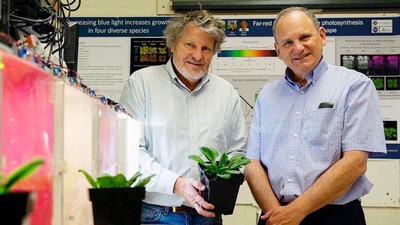Why Care About Agriculture? It's All About Quality Of Life, Professor Says
Bruce Miller, head of the School of Applied Sciences, Technology and Education, Professor Debra Spielmaker, USU Provost Noelle Cockett and President Stan Albrecht.
Debra Spielmaker is an educator/hiker/foodie/wife/skier/hockey player/mother and now a Utah State University Extension professor in the School of Applied Sciences, Technology and Education.
But when Spielmaker’s husband accompanied her to a gathering of educators he introduced himself by saying “I’m Rick, and I’m married to Ag in the Classroom.”
Spielmaker told guests at her Inaugural Professor Lecture that her husband’s introduction was on the mark since 21 of the 30 years they have been married she has been a driving force behind Agriculture in the Classroom, first in Utah and now as the program’s national director.
The Inaugural Professor Lecture series honors faculty who have been promoted to full professor in the past year.
Spielmaker titled her lecture “Contextualizing Curriculum for Authentic Learning,” but said her first impulse was to call it “So, What?” She said it seemed a fitting title because the mission of Agriculture in the Classroom is to increase agricultural literacy and that means helping people understand how agriculture affects them. That only happens when the things people learn are put into the context of their lives and learning.
A desire for people to understand the “So, what?” about agriculture has been a guiding principle in Spielmaker’s efforts to develop curriculum and support materials ever since her start with Ag in the Classroom; a start that often involved working from an ironing board she referred to as “my first standing desk.” She said the ironing board-turned-desk allowed her to work where her family was, and when she began her journey to earning advanced degrees and working with Ag in the Classroom her daughters were just 5 and 2 years old.
“I worked a lot at that ironing board,” she said. “It was important to me to be there, to cook dinner for my family, because to me that says, ‘I love you.’ It was important to do work and to be there for homework and baths and most importantly, family reading time.”
A lot of the ideas that have made Utah Ag in the Classroom a model program started at that ironing board. Agriculture in the Classroom programs are implemented on the state level to make agricultural literacy a part of K-12 teaching. Early in her career Spielmaker was asked by a reporter why it matters if people are agriculturally literate. Her answer then and now is that it matters because agriculture affects everyone’s quality of life.
“It matters because when we have food, shelter and clothing we can do and think about other things,” Spielmaker said.
She stressed that the topics Ag in the Classroom presents — with support materials and free lesson plans — are not “extra” work for already-busy teachers. They are created and shared by teachers to fit in the curriculum they already cover at each grade level and reinforce lessons across the curriculum whether in math, geography, history, science, economics, health, writing or art.
Spielmaker illustrated her conviction that people can have meaningful “interAGtions” in many ways with samples from the Ag in the Classroom toolbox. For example, students in European history gain cultural and economic insights from mapping activities focused on learning about foods produced in the Old World and New World and about trade.
In another lesson, teachers use packaged samples of various soils in teaching soil science or in discussions about the Dust Bowl and may finish out the lesson by turning the soils into an art project. Ten different lessons involve sheep and fit everywhere from kindergarten science about living things to seventh grade technical education about natural and synthetic fabrics. To execute many of the lessons well, teachers need the right supplies, which may be carded wool, posters, game boards, pipettes or various kinds of seeds. To make the lessons simpler to use, Utah Ag in the Classroom (with help from USU agricultural education students and department staff) assembles kits and sells them for just enough to cover costs through an online store, and teachers across the country are glad to outsource the task of collecting some unusual supplies.
For example, there are popular lessons that incorporate cotton bolls still on their stalks into social studies and history lessons about the cotton trade. The team in Utah gets cotton stalks from a grower in Mississippi, packages them with other materials for those lessons and often ships the packets to teachers back in Mississippi.
USU Provost Noelle Cockett said she had long admired the work Utah Ag in the Classroom did under Spielmaker’s leadership. And while other state programs and individual teachers share curriculum and materials, Utah’s program is a stand out.
“I thought that every state had a program this good and they were all creating materials and websites,” Cockett said. “Then I learned that wasn’t the case. We just have an especially innovative program here. So it was no surprise when Deb became the national Ag in the Classroom director.”
Spielmaker may have been in the agricultural education “business” for more than 20 years, but she doesn’t tire of helping people see agriculture in the context of their lives. And when a person caps an “interAgtion” with her by saying, “I’ll never look at a loaf of bread the same way again,” Spielmaker knows they’ve gotten closer to understanding that agriculture isn’t a “So, what?” it’s entwined with everything in their lives.
Learn more about Agriculture in the Classroom online.
Related links:
- USU School of Applied Sciences, Technology and Education
- USU College of Agriculture and Applied Sciences
- USU Extension
Contact: Debra Spielmaker, Debra.Spielmaker@usu.edu
Writer: Lynnette Harris, 435-797-2189, Lynnette.Harris@usu.edu
Comments and questions regarding this article may be directed to the contact person listed on this page.






